You want to adopt a Great Dane puppy. That’s exciting! However, many new puppy owners do not know where to start when it comes to researching what to expect. If that is you, don’t worry! This article will cover all of the essentials you need to know, including the cost of puppies of this breed, tips on finding reputable Great Dane breeders, and the milestones you should expect as your puppy grows up! We will also talk about Great Danes’ appearance and temperament.
In addition, you will also see plenty of pictures that show you what a Great Dane puppy might look like. That is the cutest part! Enjoy gaining these tips about raising a Great Dane puppy while perusing the photos of many adorable dogs. Let’s jump in to discover all of the facts you need to know about Great Dane puppies. Let’s go!
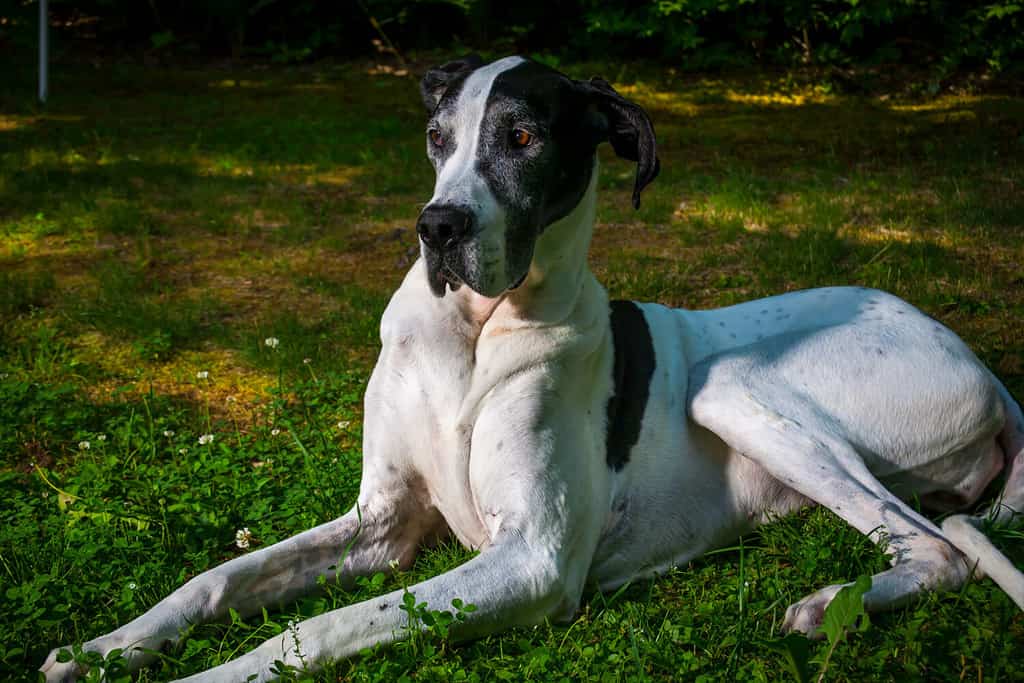
Great Danes are known for being regal “gentle giants,” since they are the tallest dog breed but are loyal and sociable.
©Arthur Villator/Shutterstock.com
About Great Danes
The Great Dane is a dog breed known for being a “gentle giant” that is loyal, courageous, friendly, dependable, and highly intelligent. These dogs are famous for their size: Great Danes are the tallest dogs in the world! As a result, they can run very quickly! In fact, they were originally bred as hunting dogs by the nobility in Europe. However, despite their name, these dogs are not Danish! These dogs actually come from a line bred in Germany. Over the years, Great Danes have been used to hunt many different animals and have been trained to be good, fast, and strong runners and companions. Although they are often described as “gentle” and calm, they serve well as guardians and protectors when necessary.
These dogs grow to be very big, with female dogs weighing as much as 140 pounds and males weighing up to 175 pounds. They live to be 7 to 10 years old on average.
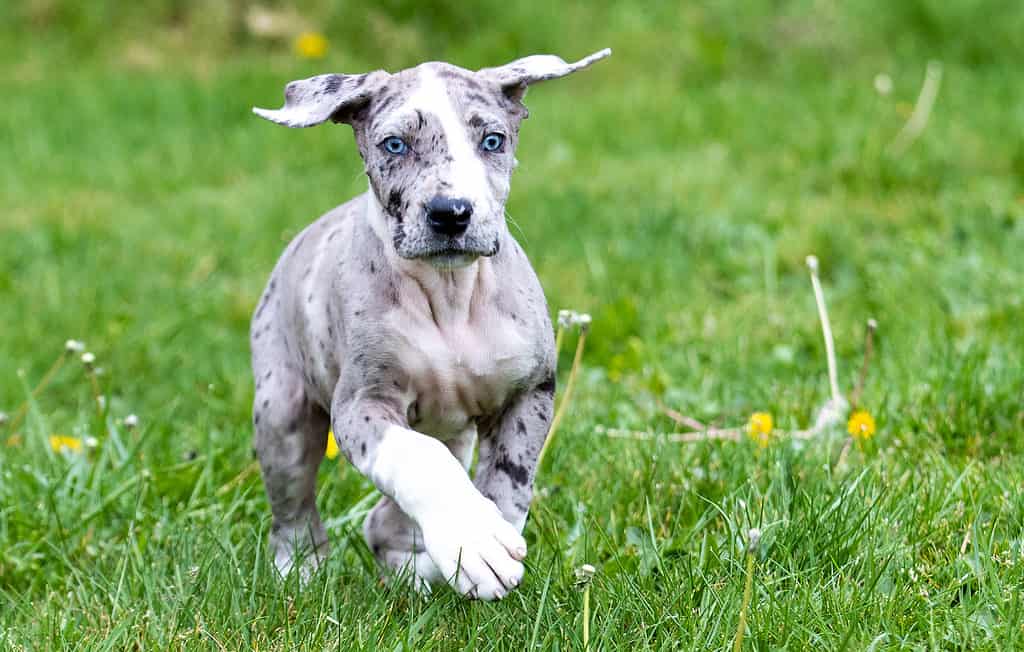
Great Dane puppies are friendly and loving companions.
©MPH Photos/Shutterstock.com
Costs for a Great Dane Puppy
Owning a dog is not cheap, so you will certainly want to plan in advance for some of the costs you can expect to pay up-front and over the course of your Great Dane’s lifetime.
Adoption Costs
Great Dane puppies can cost anywhere from $500 to over $3,000, depending on where you find them. Breeders tend to charge from $1,000 to $3,000. However, you may be able to rescue a Great Dane for $500 or less.
Insurance Costs
In addition to the costs of adopting a Great Dane, you should expect to purchase pet insurance, set up a pet savings account, and plan for veterinarian visits. Pet insurance ranges from about $20 to over $100 each month. However, pet insurance coverage varies in what it will pay for in the event of an emergency. Be sure to read your pet insurance policy and do not forget to set money aside in case you need to pay for an unexpected vet bill or other expense.
Medical Costs
You can expect to pay for vaccines, which can cost $25 to $75 each, spay or neuter surgery, which can cost between $150 and 600 depending on your pet’s gender and age, and other surgeries. Since Great Danes as a breed are prone to bloat, surgical gastropexy can be a bloat prevention surgery. However, this can cost between $500 and $1,500.
It is important for your dog to get parasite prevention medicine, including the medications to prevent fleas, ticks, and heartworms. These can cost $200 to $500 each year. Additionally, you will want to invest in dental care for your dog, including a toothbrush and toothpaste, to keep their teeth healthy.
In addition to this, you should plan for your healthy Great Dane to visit the veterinarian’s office at least once a year to get a wellness checkup. As they get older, these visits may need to increase. Each visit could cost you between $50 and $250 depending on your region in the U.S., any testing, or other needs you have during the exam.
Food Costs
Apart from medical needs your Great Dane may have, you certainly want to plan ahead for the cost of their food. These costs can vary greatly depending on how you choose to feed your dog. On average, the amount of food you will need to buy for a big dog like a Great Dane could cost you about $2,000 a year on a veterinarian-recommended diet. Choosing additional treats or creating a specialized diet could cost you even more. Some Great Dane pet owners report spending as much as several hundred dollars each month just on food costs alone.
Supplies Costs
Lastly, before you bring your Great Dane puppy home, you will want to invest in all of the necessary supplies. These are the things that will keep your pup safe and happy in its new home! Some of the essential items you will want to buy in advance will include food and water bowls, a dog brush, a collar, a leash, a car seatbelt or crate, a house crate, nail clippers, and toys. Each of these items range in price, depending on which brand you choose and any customizations or features you prioritize. In general, purchasing all of these items for the first time will cost at least several hundred dollars.
In addition to these items, you may end up spending additional money on repeat purchases like treats, dog toothpaste and toothbrushes, toys, and other items.
Training Costs
Training your Great Dane is essential. Whether you take a dog obedience class, go with your dog to a training class, or watch videos online, dog training could be as cheap as under $10 or cost up to $1,000. The option you choose will depend on you and your dog’s specific needs and the type of training you want to participate in.
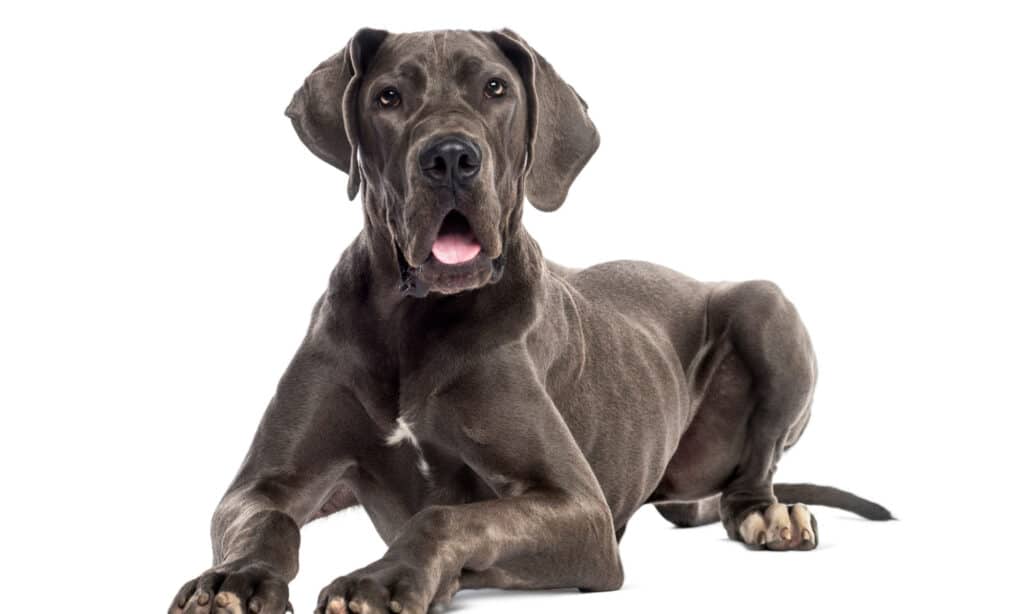
Great Danes cost more to insure because they’re prone to certain health issues.
©iStock.com/GlobalP
Tips for Finding a Great Dane Breeder
When searching for a Great Dane puppy, it is important to find an ethical and responsible breeder with the appropriate accreditation. There are plenty of search engines and guides online that can help you identify a reputable Great Dane breeder in your state. However, here are some general guidelines:
First, a reputable breeder will have the recommended genetic health tests completed. These will be accessible for both of your puppy’s parents. Second, a good breeder will typically have waitlists and will not have a puppy on hand for you to walk away with the day of. Third, a good breeder will conduct a screening of you and your household. This is to ensure the puppy goes to a good and safe home. They may even ask to conduct a home visit with you or want to know information about your house and lifestyle. Fourth, a reputable breeder may charge more. This could be because they invest time and effort into training and caring for their puppies – and this could benefit you when it comes to the puppies already having some socialization or basic training!

Great Dane puppies can be expensive to adopt, often costing between $1,000 and $3,000 when purchased from a reputable breeder.
©Eric H. Gonzalez/Shutterstock.com
Great Dane Milestones
As your Great Dane puppy grows, you can watch your pup achieve milestones in its development! This is exciting since it means your puppy is growing up healthy and strong…though you may be sad to say goodbye to your dog’s puppy days!
The first year of a Great Dane’s life is equivalent to a human’s first 14 years! After 18 to 24 months of age, a Great Dane is considered fully grown. They will reach their full height at 18 months, though they may add muscle and weight after that. Most have stopped growing by 2 years old. Here are some other Great Dane growth milestones to watch out for.
- 3 weeks: Your Great Dane’s puppy teeth start to grow in.
- 3 months: Your Great Dane’s puppy teeth fall out and adult teeth grow in.
- 7 months: Your Great Dane puppy has all of its adult teeth.
- 8-12 months: Your Great Dane puppy may be spayed or neutered.
- 18 months: Your Great Dane reaches its full height. At this point, you can switch your pet over from puppy food to adult food.
- 24 months: Your Great Dane reaches its adult weight and is considered an adult dog!
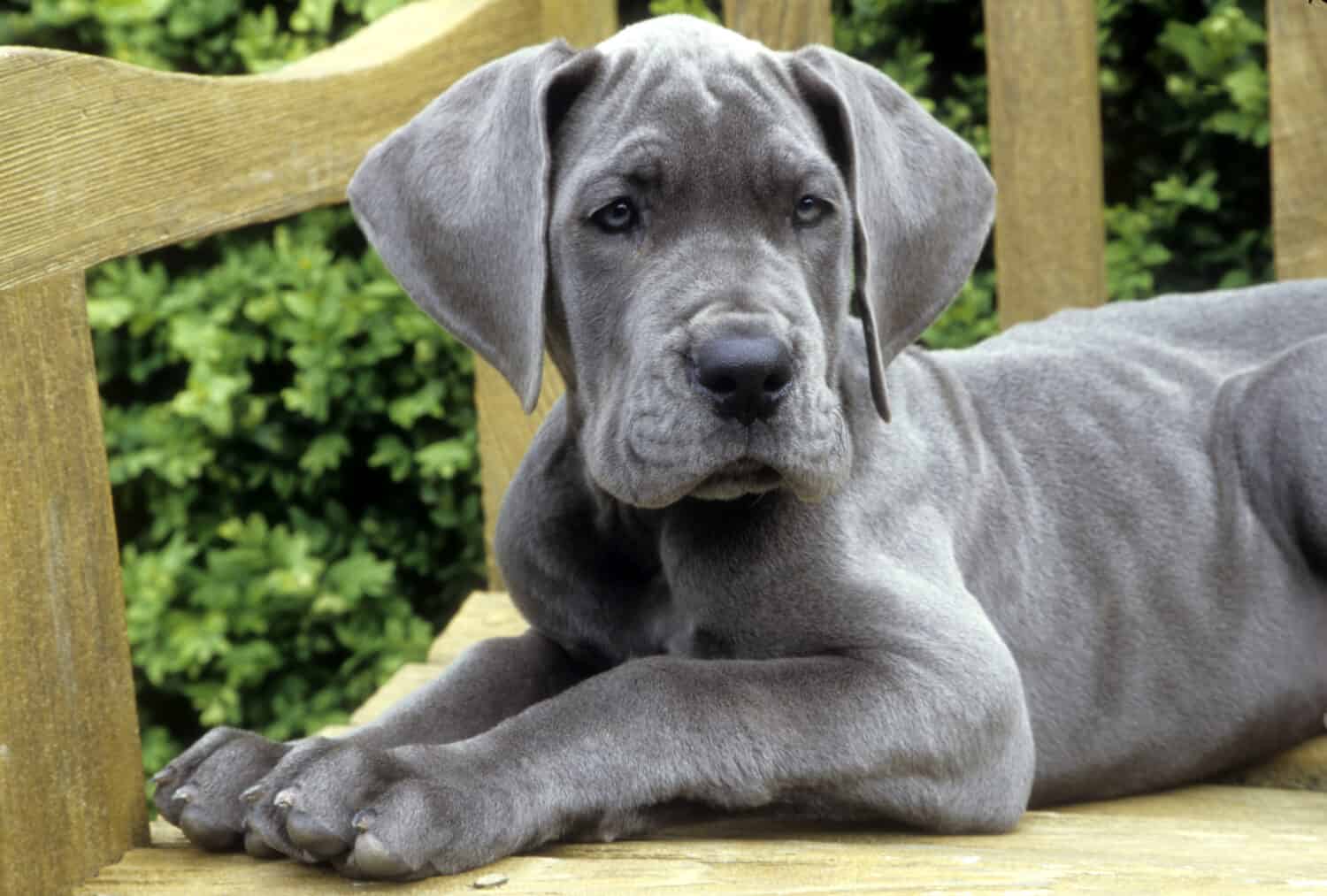
Great Dane puppies grow and lose baby teeth to be replaced by adult teeth, just like human children do.
©Jerry Shulman/Shutterstock.com
Growth and Weight Chart
| Age | Male Weight | Female Weight |
|---|---|---|
| Birth | 1-3 pounds | 1-3 pounds |
| 1 Month | 5-8 pounds | 4-7 pounds |
| 6 Weeks | 6-13 pounds | 5-10 pounds |
| 2 Months | 15-30 pounds | 12-25 pounds |
| 3 Months | 25-45 pounds | 20-35 pounds |
| 4 Months | 45-65 pounds | 40-55 pounds |
| 5 Months | 60-85 pounds | 55-70 pounds |
| 6 Months | 65-100 pounds | 60-85 pounds |
| 7 Months | 70-110 pounds | 65-90 pounds |
| 8 Months | 80-120 pounds | 70-100 pounds |
| 9 Months | 85-125 pounds | 75-105 pounds |
| 10 Months | 90-130 pounds | 80-110 pounds |
| 11 Months | 90-135 pounds | 80-115 pounds |
| 12 Months | 95-140 pounds | 85-120 pounds |
| 2 Years | 135-165 pounds | 110-140 pounds |
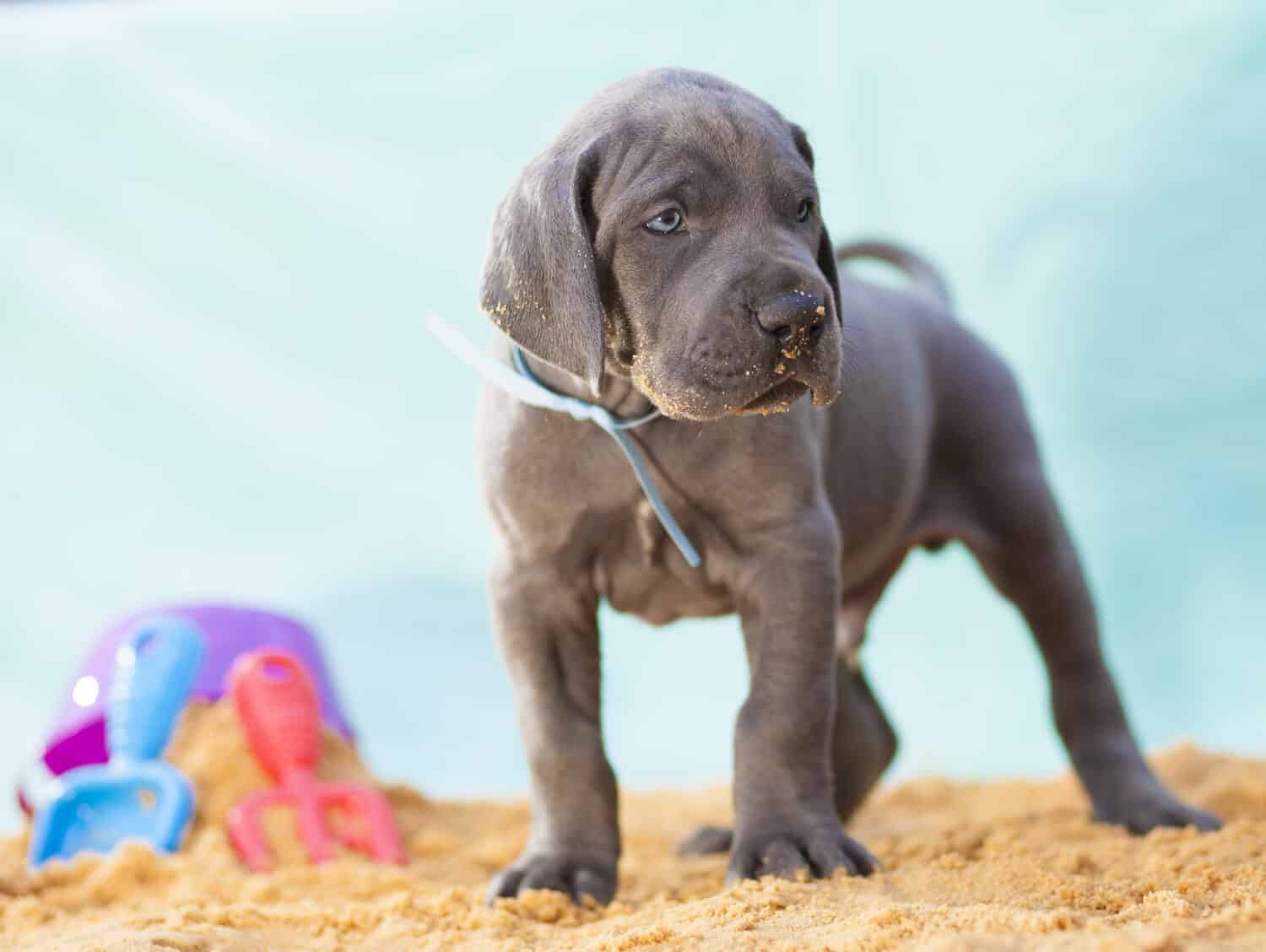
Great Dane puppies grow quickly, gaining most of their height and weight within their first 18 months of life, growing to weigh well over 100 pounds by adulthood.
©Guy J. Sagi/Shutterstock.com
Appearance of Great Danes
According to the American Kennel Club, these dogs combine “regal appearance, strength, and elegance with great size and a powerful, well-formed, smoothly muscled body.” These dogs grow from tiny puppies to gigantic adults. Female Great Danes reach at least 28 inches from foot to shoulder, while male Great Danes tend to grow to at least 30 inches from foot to shoulder. However, the tallest Great Danes grow to be up to 43 or even 44 inches to the shoulder! With such great height, these big dogs also achieve significant weights, ranging from at least 100 to 140 pounds for female dogs and 140 to 175 pounds for male dogs. Yet they achieve this immense size without losing their grace, and they retain an ability to move quickly and smoothly with long, elegant strides.
Standard Great Dane colors (according to the American Kennel Club) are black, black and white, blue, brindle, fawn, harlequin, mantle, merle, white, and silver. Their standard markings include black markings, white markings, or a black mask.

Purebred Great Dane puppies come in a range of colors recognized as standard by the American Kennel Club: black, black and white, blue, brindle, fawn, harlequin, mantle, merle, white, and silver. Their standard markings include black markings, white markings, or a black mask.
©Carina Bekker/Shutterstock.com
What to Expect When Caring for a Great Dane Puppy
Feeding Your Great Dane
Don’t be surprised if your Great Dane eats a lot! Giving your puppy high-quality food customized for its age will help it grow up healthy and strong. As your dog grows, you can adjust the food to be age-appropriate with the advice of a veterinarian. It is also important for Great Dane owners to know that bloat is a deadly killer of these dogs. Bloat is not well understood, but dog experts do suggest giving your Great Dane small meals during the day and avoiding rigorous exercise at mealtimes. It is always best to consult with a veterinarian on the best ways to prevent bloat in your pet and take the steps necessary to treat your dog.
Grooming Your Great Dane
When caring for a Great Dane, you can expect to have a dog with a short coat that does not shed too much. However, the size of the dog means that you may find a fair amount of fur in your house. Your Great Dane will shed once or twice a year, but during these seasons should be brushed once a day.
Exercising Your Great Dane
Great Danes need a lot of exercise to stay healthy and happy. Taking your Great Dane puppy on a walk two or three times a day will help your dog to get enough exercise. However, avoid taking your dog on vigorous walks around mealtimes when they can be prone to bloat. If you want to bring your Great Dane on a hike or a run, you may find that they are a perfect companion. However, do not bring your Great Dane puppy on a jog until your pup has reached at least two years of age. This will help avoid any damage to your dog’s developing joints while they are still a puppy.

Great Dane puppies are energetic and playful.
©Dmussman/Shutterstock.com
Training Your Great Dane
You will want to ensure that your Great Dane puppy gets socialization and training right away. Since Great Danes are big and powerful dogs, leash training and obedience lessons are essential to keeping you, your dog, and those around you safe and calm. Since Great Danes are outgoing, friendly dogs and want to please their owners, you will likely find that your puppy responds well to consistent training, affection, and socialization around other people and dogs.

Great Danes should go on at least 2 to 3 walks each day to get enough exercise.
©Sarka Nemeckova/Shutterstock.com
The Personality of Great Danes
Unlike some other large dog breeds, Great Danes are known for being relatively gentle and calm. Even as puppies, these dogs are not the most rambunctious or hyper. Though they can be playful and goofy, and love playing with their owners, they can also be content to lounge on the couch or take a peaceful afternoon nap. However, do not let that keep you from giving your Great Dane enough walks! Take your dog on at least two or three walks a day to ensure these big dogs get enough exercise and time outside. However, the rest of the time, you can enjoy hanging out with a peaceful and tame dog that is companionable but does not require the same level of intellectual stimulation or hands-on playtime as other breeds.

Great Danes have a gentle, sweet temperament.
©iStock.com/Jesus Manuel Souto Blanco
The photo featured at the top of this post is © Guy J. Sagi/Shutterstock.com
Thank you for reading! Have some feedback for us? Contact the AZ Animals editorial team.






